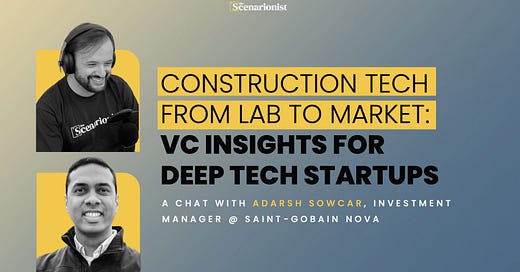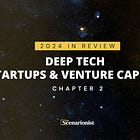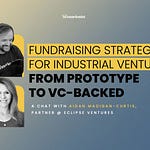✨ HI There! This is a Free Edition of The Scenarionist. To enjoy the full experience, become a Premium Member!
The Scenarionist Premium is designed to make you a better Deep Tech Founder, Investor, and Operator. Premium members gain exclusive access to unique insights, analysis, and masterclasses with the wisdom of the world’s leading Deep Tech thought leaders. Invest in yourself, and upgrade today!
Welcome to the 58th edition of Deep Tech Catalyst, the channel by The Scenarionist where science meets venture!
The construction industry is facing unprecedented challenges, including rapid urbanization, the need for sustainable materials, and the urgency to reduce its carbon footprint. These pressing issues demand innovative solutions to transform the way we build and live.
To help navigate these challenges and provide valuable insights, we are thrilled to welcome Adarsh Sowcar, Venture Investment Manager at Saint-Gobain NOVA!
What you will get:
🧱 3 Numbers Redefining the Construction Industry: Explore 3 key data points driving the need for advanced construction technologies and innovative materials.
🏗️ 2 Critical Innovation Areas in the Construction Sector: From sustainable building materials to revolutionary construction processes, we'll highlight the areas where startups can make the biggest impact.
✅ 3 Essential Steps to Succeed in Construction: We'll provide practical strategies for startup founders to navigate the complexities of the construction industry and achieve success.
🎯 VC Expectations for Pre-Seed and Seed-Stage Startups: We'll discuss what venture capitalists look for in early-stage startups and how founders can position their companies for investment.
KEY INSIGHTS FROM THE EPISODE
🧱 3 Numbers Redefining the Construction Industry
By 2050, around 70% of the global population will live in urban areas.
The rapid pace of urbanization is a defining factor driving the building materials industry. By 2050, approximately 70% of the world’s population is expected to reside in large cities. This unprecedented shift toward urban living demands advanced construction technologies and innovative materials to meet the growing needs of urban environments. Urbanization is not just about housing more people; it’s about creating sustainable, efficient, and livable spaces that improve quality of life.
On average, people spend over 80% of their time indoors.
Modern lifestyles put a spotlight on indoor environments, making occupant comfort and well-being a priority in construction. With people spending more than 80% of their time inside buildings, there is an increasing focus on materials that enhance indoor air quality, thermal comfort, and noise reduction. Building materials are evolving to support healthier, more comfortable living spaces, reflecting the growing emphasis on occupant-centered design.
Nearly 40% of global CO₂ emissions are tied to the construction sector.
One of the biggest challenges facing the construction industry is its environmental impact. The sector is responsible for nearly 40% of global carbon dioxide emissions, underscoring the urgency for decarbonization. Leading companies are spearheading initiatives to reduce the carbon footprint of building materials. By embracing sustainable practices and green technologies, the industry is tackling climate change head-on while creating opportunities for innovation.
🏗️ 2 Critical Innovation Areas in the Construction Sector
From urbanization to environmental sustainability, the need for innovative solutions in the construction industry has never been greater—particularly in two key areas.
1. Sustainable and High-Performance Building Materials
Startups developing building materials with a lower carbon footprint are at the forefront of innovation. These materials aim to enhance energy efficiency, promote circularity, and improve occupant comfort and quality of life.
This category includes:
Materials that reduce energy consumption in buildings.
Components designed for sustainability and recycling.
Solutions that address indoor environmental quality.
These innovations align with the growing demand for greener, healthier, and more sustainable construction practices.
2. Revolutionizing the Construction Process
The construction industry has been slow to adopt new technologies, with productivity remaining stagnant for over 50 years. This creates a significant opportunity for startups to introduce cutting-edge solutions that can transform how buildings are constructed.
Key areas of focus include:
Robotics: Automating repetitive or labor-intensive tasks to improve efficiency and precision.
Digitization: Leveraging digital tools and platforms for better project management, planning, and execution.
Offsite Construction: Prefabrication and modular construction methods that reduce waste, speed up timelines, and enhance quality control.
🚀 A Call to Entrepreneurs
The building materials and construction sectors are actively seeking innovative entrepreneurs to address critical challenges in these two areas. Startups that can develop scalable, sustainable solutions to enhance material performance and improve construction processes have a unique opportunity to drive meaningful change in the industry.
✅ 3 Essential Steps to Succeed in Construction
Breaking into the construction industry requires more than just groundbreaking technology—it demands a deep understanding of the industry’s challenges and practical solutions to address them. Here are 3 steps for startup founders.
1. Be customer-obsessed and articulate the problem clearly.
Entrepreneurs must demonstrate a thorough understanding of the industry problem they aim to solve. Many founders come from academic or research backgrounds with strong technical expertise but lack exposure to real-world challenges in the construction sector. Spending time on construction sites, talking to general contractors, and engaging with end customers can provide critical insights.
2. Show how your technology solves a specific problem better than existing alternatives.
A startup’s solution must align with the identified problem and demonstrate a clear product-market fit. It's essential to pinpoint where the technology fits within the industry and how it creates differentiation or adds value.
3. Position your technology as a drop-in replacement or minimize barriers to adoption.
The construction sector is inherently conservative, with stakeholders hesitant to adopt solutions that disrupt established processes. A successful startup must consider how its technology can integrate seamlessly into existing workflows without requiring major changes that could increase risks or costs.
🎯 VC Expectations for Pre-Seed and Seed-Stage Startups in Building Materials
In the construction and building materials sectors, real-world performance and scalability are critical due to the high stakes involved. Investors prioritize startups that demonstrate not only technical capability but also a clear pathway to market adoption and economic feasibility.
Moreover, VCs in building materials are eager to collaborate with startups that combine technical expertise with industry insight. Founders who can deeply understand problems, define the value of their solutions, and demonstrate adaptability to existing workflows have the best chance of success.
Let’s review the basic VC expectations across the very early stages of a company.
Pre-Seed Stage: From Concept to Validation
At the pre-seed stage, startups must focus on laying a strong technical and market foundation. This includes:
1. Proof of Concept Development
Startups need to develop a working prototype or validate the composition of materials for real-world applications. This phase must demonstrate the material's technical feasibility and scalability.
2. Early Market Validation
Engaging with industry stakeholders to gather feedback is crucial. A strong indicator of success is potential customers or partners expressing interest in the technology or its applications. Demonstrating that the product has commercial potential builds credibility with investors.
3. Preliminary Unit Economics
Startup founders should be able to present rough cost-per-unit analyses based on early projections (e.g., cost per kilogram or unit). This helps investors assess financial viability at scale.
4. Scalability Considerations
Even at this early stage, startups should try to consider how their solution can scale—whether through in-house production or partnerships. These considerations help position the business for future growth and provide a framework for understanding how costs might evolve with production, including raw materials, manufacturing, and logistics.
Seed Stage: Pilot Testing and Deployment Readiness
In the seed stage, startups shift from concept validation to practical implementation and readiness for market entry. Key focus areas include:
1. Extensive Product Testing
Demonstrating real-world performance is critical. This includes tests for aging, durability, and field performance under actual conditions. These evaluations ensure the technology meets industry standards and performs reliably in diverse environments.
2. Market Viability & Pilot Agreements
Founders must clearly articulate the market demand for their product. This includes identifying target customers, aligning pricing strategies with market expectations, and showcasing the scalability of the technology for broader applications. Securing pilot programs or formal agreements with potential customers validates market interest and signals readiness for adoption. Signed pilot agreements or letters of intent are strong indicators of progress and provide valuable feedback for refining the product.
3. Scaling and Deployment Strategy
Startups should present a clear plan for scaling their solution. This could involve internal scaling capabilities or partnerships with established manufacturers. Identifying a beachhead market—an initial target segment where the technology provides maximum value—is essential to creating momentum and securing market entry.
4. Go-to-Market Strategy
Articulating a detailed plan for market entry, including target customers, distribution channels, and anticipated challenges, is a crucial step at this stage. A strong go-to-market strategy demonstrates an understanding of market dynamics and ensures efficient resource allocation during scaling.
5. Early Financial Projections
Startups at the seed stage are expected to create preliminary financial models that include revenue forecasts, scaled cost estimates, and profitability potential. These projections demonstrate the solution’s economic feasibility and instill confidence in the company’s financial planning among investors.
💡 Final Advice for Aspiring Deep Tech Founders
Start Early: Integrate financial modeling with R&D efforts to align technology development with market needs.
Seek Guidance: Leverage advisors, mentors, or investors to strengthen understanding of market and financial dynamics.
Balance Innovation and Economics: Technical breakthroughs are essential, but financial viability ultimately determines market success.
BEFORE YOU GO, DON’T MISS OUR LATEST SERIES
2024 in Review: Deep Tech Startups & Venture Capital
Over the past year, week after week, our Deep Tech Briefings explored these pivotal moments. We analyzed the trends, connected the dots, and reflected on the implications—not just for the present, but for the future of the industry.
This isn’t just a look back—it’s a toolkit for navigating what’s next.
COMMUNITY CORNER
🤔 How Can We Help You?
Is there a specific topic you'd like Deep Tech Catalyst to explore further? Whether it's venture building, portfolio support, or mindset, we'd love to hear from you!
Drop us a line 👉 hello@thescenarionist.com
🫵 How Can You Help Us?
If you find our educational content valuable, spread the word about our work. Share your positive experience on social media and tag us—we’d love to see your feedback and feature it in our community!

















